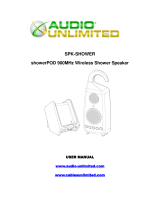User’s Guide – 900MHz Stereo Audio Transmitter & Receiver 13
ONE YEAR LIMITED WARRANTY (USA)
Products manufactured by APPLIED
WIRELESS, INC. (AW) and sold to
purchasers in the USA are warranted by
AW according to the following terms and
conditions. You should read this Warranty
thoroughly.
• WHAT IS COVERED, AND DURATION OF
COVERAGE
:
AW warrants the product to be free from
defects in materials and workmanship for
one (1) year from the date of purchase by
the original end user purchaser.
• WHAT IS NOT COVERED:
This warranty does not apply to the
following:
1. Damage caused by accident,
physical or electrical misuse or
abuse, improper installation, failure to
follow instructions contained in the
User’s Guide, any use contrary to the
product’s intended function,
unauthorized service or alteration
(i.e. service or alteration by anyone
other than AW).
2. Damage occurring during shipment.
3. Damage caused by acts of God,
including without limitation:
earthquake, fire, flood, storms, or
other acts of nature.
4. Damage or malfunction caused by
the intrusion of moisture or other
contamination within the product.
5. Batteries supplied by AW in or for the
product.
6. Cosmetic deterioration of chassis,
cases, or pushbuttons resulting from
wear and tear typical of normal use.
7. Any cost or expense related to
trouble-shooting to determine
whether a malfunction is due to a
defect in the product itself, in the
installation, or any combination
thereof.
8. Any cost or expense related to
repairing or correcting the installation
of an AW product.
9. Any cost or expense related to the
removal or reinstallation of the
product.
10. Any product whose serial number or
date code is altered, defaced,
obliterated, destroyed, or removed.
This warranty is extended to the original
purchaser of the product(s) only, and is
not transferable to any subsequent owner
or owners of the product(s). AW reserves
the right to make changes or
improvements in its products without
incurring any obligation to similarly alter
products previously purchased.
• EXCLUSION OF INCIDENTAL OR
CONSEQUENTIAL DAMAGES
:
AW expressly disclaims liability for
incidental and consequential damages
caused (or allegedly caused) by the
product. The term “incidental or
consequential damages” refers (but is not
limited) to:
1. Expenses of transporting the product
to AW to obtain service.
2. Loss of use of the product.
3. Loss of the original purchaser’s time.
• LIMITATION OF IMPLIED WARRANTIES:
This warranty limits AW’s liability to the
repair or replacement of the product. AW
makes no express warranty of
merchantability or fitness for use. Any
implied warranties, including fitness for
use and merchantability, are limited in
duration to the period of the one (1) year
express limited warranty set forth herein.
The remedies provided under this
warranty are exclusive and in lieu of all
others. AW neither assumes nor
authorizes any person or organization to
make any warranties or assume any
liability in connection with the sale,
installation, or use of this product.
Some states do not allow limitations on
how long an implied warranty lasts, and
some states do not allow the exclusion or
limitation of liability for incidental or
consequential damages so the limitations
or exclusions stated herein may not apply
to you. This warranty gives you specific
legal rights and you may have other rights
which vary from state to state.
(continued on next page)
14 Applied Wireless, Inc.
ONE YEAR LIMITED WARRANTY (USA), cont.
• HOW TO OBTAIN WARRANTY SERVICE:
If a product covered by this warranty and sold in the USA by AW proves to be defective
during the warranty period AW will, at its sole option, repair it or replace it with a
comparable new or reconditioned product without charge for parts and labor, when said
product is returned in compliance with the following requirements:
1. You must first contact AW at the following address/phone for assistance:
APPLIED WIRELESS, INC.
1250 Avenida Acaso, Suite F
Camarillo, CA 93012
Phone: (805) 383-9600
If you are instructed to return your product directly to the factory, a Return
Merchandise Authorization number (RMA) will be issued to you.
2. You must package the product carefully and ship it insured and prepaid. The RMA
number must be clearly indicated on the outside of the shipping container. Any
product returned without an RMA number will be refused delivery.
3. In order for AW to perform service under warranty, you must include the following:
(a) Your name, return shipping address (not a PO Box), and daytime telephone number.
(b) Proof of purchase showing the date of purchase.
(c) A detailed description of the defect or problem.
Upon completion of service, AW will ship the product to the specified return shipping
address. The method of shipping shall be at AW’s sole discretion. The cost of return
shipping (within USA) shall be borne by AW.











